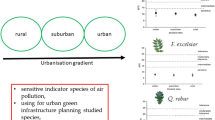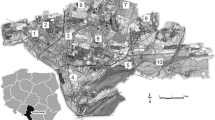Abstract
Concentrations of five metals (cadmium, chromium, copper, nickel and lead) were determined in tree leaves collected from 13 areas of the Attica basin and Athens city, Greece. Geographical distribution patterns were investigated, and factors affecting toxic element accumulation in trees were discussed. The mean heavy metal content in the tree leaves is described in the descending order of copper > lead > nickel > chromium > cadmium. Generally, the most damaged areas have been proved to be those near the city center and in the vicinity of the Attica highway. The geomorphological relief of the area plays an important role in the dispersion of airborne particles from pollution sources to the surrounding area. Areas on the NE region are also polluted mainly due to wind directions. In Citrus aurantium leaves, with relatively impermeable cuticle, high chromium, copper and nickel concentration would be possibly caused only by significant stomatal uptake. The conifer tree Pinus brutia providing a rough leaf surface also showed elevated concentrations, especially of cadmium and lead. The thick waxy cuticle of the sclerophyllous broadleaved Olea europaea forms a smooth sheet increasing the barrier properties of the leaf epidermis and causing a reduction in leaf permeability. The dense trichomes of the abaxial epidermis of Olea europaea also act as a pollution screen keeping away the air particles from the epidermis stomata. The presence of a certain metal within the leaf cells could reduce the uptake or toxicity of some others.












Similar content being viewed by others
References
Chaloulakou A, Mavroidis I (2002) Comparison of indoor and outdoor concentrations of CO at a public school. Evaluation of an indoor air quality model. Atmos Environ 36:1769–1781
Sirito de Vives A, Moreira S, Boscolo Brienza S, Silva Medeiros J, Filho M, Zucchi O, Nascimento Filho V (2006) Monitoring of the environmental pollution by trace element analysis in tree-rings using synchrotron radiation total reflection X-ray fluorescence. Spectrochemica Acta 61:1170–1174
Oliva S, Espinoza AJ (2007) Monitoring of heavy metals in topsoils, atmospheric particles and plant leaves to identify possible contamination sources. Microchem J 86:131–139
Klemm O, Ziomas IC, Balis D, Suppan P, Slemr J, Romero R, Vyras LG (1998) A summer air pollution study in Athens, Greece. Atmos Environ 32:2071–2087
Kousa A, Oglesby L, Koistinen K, Künzli N, Jantunen M (2002) Exposure chain of urban air PM2.5-associations between ambient fixed site, residential outdoor, indoor, workplace and personal exposure in four European cities in the EXPOLIS-study. Atmos Environ 36:3031–3039
WHO (World Health Organization) (1999) Health costs due to road traffic-related air pollution. WHO Copenhagen
Markert B (1995) Sample preparation (cleaning, drying, homogenization) for trace element analysis in plant matrices. Sci Total Environ 176:45–61
Baker AJM, Mc Grath SP, Reeves RD, Smith JAC (2000) Metal hyperaccumulator plants: a review of the ecology and physiology of a biological resource for phytoremediation of metal polluted-soils. In: Terry N, Benuelos G (eds) Phytoremediation of contaminated soil and water. Lewis Publisers, London, pp 85–107
Ma LQ, Komar KM, Tu C, Zhang W, Cai Y, Kenelley ED (2001) A fern that hyperaccumulates arsenic. Nature 409:579
Gajić G, Mitrović M, Pavlović P, Stevanović B, Djurdjević L, Kostić O (2009) An assessment of the tolerance of Ligustrum ovalifolium Hassk. to traffic-generated Pb using physiological and biochemical markers. Ecotoxicol Environ Saf 72:1090–1101
Murin A (1995) Basic criteria for selection of plant bioindicators from the regional flora for monitoring of an environmental pollution. Biologia 50:37–40
Small E (1972) Photosynthetic rates, in relation to nitrogen recycling as an adaptation to nutrient deficiency in peat bog plants. Can J Bot 50:2227–2233
Kikuzawa K, Kudo (1995) Effects of the length of the snow-free period on leaf longevity in alpine shrubs: a cost-benefit model. Oikos 73:214–220
Sawidis T, Marnasidis A, Zachariadis GA, Stratis JA (1995) A study of air pollution with heavy metals in Thessaloniki city (Greece) using trees as biological indicators. Arch Environ Contam Toxicol 28:118–124
Sawidis T, Chettri MK, Papaioannou A, Zachariadis GA, Stratis J (2001) A study of metal distribution from lignite fuels using trees as biological monitors. Ecotox Environ Saf 48:27–35
Sawidis T, Breuste J, Mitrovic M, Pavlovic P, Tsigaridas K (2011) Trees as bioindicators of heavy metal pollution in three European cities. Environ Pollut 159:3560–3570
Askoy A, Öztürk M (1996) Phoenix dactylifera as a biomonitor of heavy metal pollution in Turkey. J Trace Micropr Techn 14:605–614
Al-Shajeb SM, Al-Rajhi MA, Seaward MRD (1995) The date palm (Phoenix dactylifera L.) as a biomonitor of lead and other elements in arid environments. Sci Total Environ 168:1–10
Dmuchoswski W, Bytnerowicz A (1995) Monitoring environmental pollution in Poland by chemical analysis of Scots Pine (Pinus sylvestris L.) needles. Environ Pollut 87:84–104
Lombardo M, Melati RM, Orecchio S (2001) Assessment of the quality of the air in the city of Palermo through chemical and cells analyses on Pinus needles. Atmos Environ 35:6435–6445
Dongarra G, Sabbatino G, Triscari M, Varrica D (2003) The effects of anthropogenic particulate emissions on roadway dust and Nerium oleander leaves in Messina (Sicily, Italy). J Environ Monit 5:766–773
Lorenzini G, Grassi C, Nali C, Petiti A, Loppi S, Tognotti L (2006) Leaves of Pittosporum tobira as indicators of airborne trace element and PM10 distribution in central Italy. Atmos Environ 40:4025–4036
Pyatt FB (2001) Comparison of foliar and stem bioaccumulation by Accacia retinides and Eucalyptus torquatain sites contaminated as a consequence of extensive ancient mining activities in Cyprus. Ecotox Environ Saf 50:60–64
Djingova R, Ivanova J, Wagner G, Korhammer S, Market B (2001) Distribution of lanthanoids, Be, Bi, Ga, Te, Tl, Th and U on the territory of Bulgaria using Populus nigra “Italica” as an indicator. Sci Total Environ 234:175–184
Moraes RM, Delitti WBC, Moraes JAPV (2003) Gas exchange, growth and chemical parameters in a native Atlantic forest tree species of Cubatao, Brazil. Ecotox Environ Saf 54:339–345
Lau OW, Luk SF (2001) Leaves of Bauhinia blakeana as indicators of atmospheric pollution in Hong Kong. Atmos Environ 242:57–88
Baycu G, Tolunay D, Özden H, Günebakan S (2006) Ecophysiological and seasonal variations in Cd, Pb, Zn and Ni concentrations in urban deciduous trees in Istanbul. Environ Pollut 143:545–554
Moussiopoulos N (1994) Air pollution in Athens. Urban air pollution, vol 1. Computational Mechanics Publications, Boston MA, pp 3–41
Öztürk MA, Turkan I (1993) Heavy metal accumulation by plants growing alongside the motor roads: a case study from Turkey. In: Markert B (ed) Plants as biomonitors. VCH, Weinheim, New York, Basel, Cambridge, pp 515–522
Welz B (1985) Atomic absorption spectrometry. VCH, Weinheim, Germany, p 506
Mantis HT, Repapis C, Zerefos CS, Ziomas J (1992) Assessment of the potential for the photochemical air pollution in Athens: a comparison of emissions and air pollutant levels in Athens with those of Los Angeles. J Appl Meteorol 31:1467–1476
Melas D, Ziomas I, Klemm O, Zerefos C (1998) Anatomy of sea breeze circulation in Greater Athens under weak large-scale ambient winds. Atmos Environ 32:2223–2237
Thomaidis NS, Bakeas EB, Siskos PA (2003) Characterization of lead, cadmium, arsenic and nickel in PM2:5 particles in the Athens atmosphere, Greece. Chemosphere 52:959–966
Bargagli R (1998) Trace elements in terrestrial plants: an ecophysiological approach to biomonitoring and biorecovery. Springer-Verlag, Berlin
Greger M (1999) Metal availability and bioconcentration in plants. In: Prasad MNV, Hagemeyer J (eds) Heavy metal stress in plants. From molecules to ecosystems, Springer-Verlag, Berlin, pp 1–27
Demidchick V, Davenport RJ, Tester M (2002) Nonselective cation channels in plants. Ann Rev Plant Biol 53:67–107
Siedlecka A, Tukendorf A, Skorzynska P, Maksymiec W, Wojcik M, Baszynski T, Krupa Z (2001) Angiosperms (Asteraceae, Convolvulaceae, Fabaceae, and Poacea; other than Brassicaceae). In: Prasad MNV (ed) Metals in the environment. Analysis by biodiversity. Dekker M Inc, New York, pp 171–217
Rengel Z (1997) Mechanisms of plants resistance to toxicity of aluminium and heavy metals. In: Basra AS, Basra RK (eds) Mechanisms of environmental stress resistance in plants. Harwood Academic Publishers, Amsterdam, pp 241–276
Prasad MNV, Hagemeyer J (1999) Heavy metal stress in plants. From molecules to ecosystems. Springer- Verlag, Berlin
Kabata-Pendias A, Pendias H (2001) Trace elements in soils and plants, 3rd edn. CRC Press, Boca Raton, Florida, USA
Kabata-Pendias A, Piotrowska M, Dutka S (1993) Trace metals in legumes and monocotyledons and their suitability for the assessment of soil contamination. In: Markert B (ed) Plants as biomonitors. Indicators for heavy metals in the terrestrial environment, pp. 485–494
Spink AJ, Parsons AN (1995) An experimental investigation of the effects of nitrogen deposition to Narthecium ossifragum. Environ Pollut 2:191–198
Meng FR, Bourque CPA, Belczewski RF, Whitney NJ, Arp PA (1995) Foliage responses of spruce trees to long-term low-grade sulfur dioxide deposition. Environ Pollut 2:143–152
Alfani A, Maisto G, Iovieno P, Rutgliano FA, Bartoli G (1996) Leaf contamination by atmospheric pollutants as assessed by elemental analysis of leaf tissue, leaf surface deposit and soil. J Plant Physiol 148:243–248
Schreiber L, Riederer M (1996) Ecophysiology of cuticular transpiration: comparative investigation of cuticular water permeability of plant species from different habitats. Oecologia 107:426–432
Riederer M, Schneider G (1990) The effect of the environment on the permeability and composition of Citrus leaf cuticles. II. Composition of soluble cuticular lipids and correlation with transport properties. Planta 180:154–165
Geyer U, Schönherr J (1990) The effect of the environment on the permeability and composition of Citrus leaf cuticles I. Water permeability of isolated cuticular membranes. Planta 180:147–153
Barber JL, Thomas GO, Kerstiens G, Jones KC (2004) Current issues and uncertainties in the measurement and modeling of air–vegetation exchange and within-plant processing of POPs. Environ Pollut 128:99–138
Turunen M, Huttunen S (1990) A review of the response of epicuticular wax of conifer needles to air pollution. J Environ Qual 19:35–45
Huttunen S (1994) Effects of air pollutants on epicuticular wax structure. In: Percy KE, Cape JN, Jagels R, Simpson CJ (eds) Air pollutants and the leaf cuticle (NATO ASI Series, Vol G 36). Springer-Verlag, Berlin, pp 81–96
Riederer M, Badot PM, Garrec JP, Richard B, Schreiber L, Sümmchen P, Uhlig M, Wienhaus O (1995) The plant cuticle as an interface between leaves and air-borne pollutants. In: INRA, EUROSILVA—Contribution to forest tree physiology, Dourdan (France), November 7–10, pp. 101–118
Cape JN (1994) Evaluation of pollutant critical levels from leaf surface characteristics. In: Percy KE, Cape JN, Jagels R, Simpson CJ (eds) Air pollutants and the leaf cuticle (NATO ASI Series, Vol G 36). Springer-Verlag, Berlin, pp 123–137
Percy KE, Mc Quattie CJ, Rebbeck JA (1994) Effects of air pollutants on epicuticular wax chemical composition. In: Percy KE, Cape JN, Jagels R, Simpson CJ (eds) Air pollutants and the leaf cuticle. NATO ASI Series 36. Springer-Verlag, Berlin, pp 67–79
Wehrli B, Stumm W (1989) Vanadyl in natural waters: adsorption and hydrolysis promote oxygenation. Geochim Cosmochim Acta 53:69–77
Streit B, Stumm W (1993) Chemical properties of metals and the process of bioaccumulation in terrestrial plants. In: Markert B (ed) Plants as biomonitors. VCH, Weinheim New York Basel Cambridge, pp 31–62
Author information
Authors and Affiliations
Corresponding author
Rights and permissions
About this article
Cite this article
Sawidis, T., Krystallidis, P., Veros, D. et al. A Study of Air Pollution with Heavy Metals in Athens City and Attica Basin Using Evergreen Trees as Biological Indicators. Biol Trace Elem Res 148, 396–408 (2012). https://doi.org/10.1007/s12011-012-9378-9
Received:
Accepted:
Published:
Issue Date:
DOI: https://doi.org/10.1007/s12011-012-9378-9




